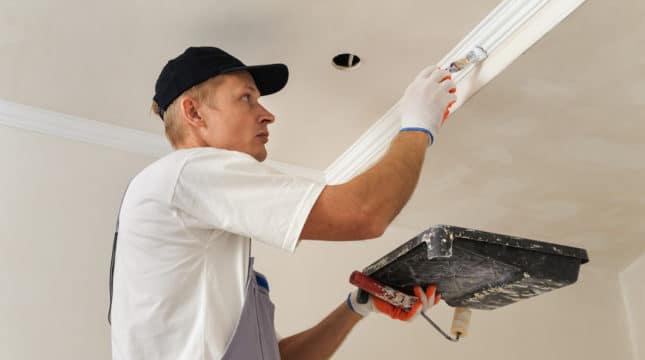Do I need a license or certification to paint houses?
There’s no federal law requiring house painters to carry a occupational license. But if you’re working on a building built before 1978, you may need a lead paint certification from the Environmental Protection Agency (EPA).
Some states require painters to have licenses and you may need a contractor’s license for bigger jobs.
Getting a business license usually requires having supervised work experience, passing an exam and showing proof of painter insurance.
Getting painter work experience
There are a few ways to get supervised work experience as a house painter. You can become a formal apprentice to a licensed contractor or work as a painter’s “helper” — check with your local rules for exact requirements.
If you’re already established as a painter and thinking of leveling up your own painting business, you might consider getting additional certifications. National organizations like the Master Painters Institute and Painter USA provide training programs tailored for painters of different skill levels.
Tax forms and business structure setup
Once you have your painter’s license or any permits and certifications taken care of, you can set up your company. One of the biggest decisions you need to make when starting a new painting business is what sort of business entity you will select.
Each structure has its own pros and cons, and the structure you choose can have major tax implications and effects on your business.
Consider meeting with a tax professional or startup attorney before making your final selection. There are three basic business structures for small businesses:
- Sole Proprietorship: If you will be the only owner, you might prefer the simplicity of being a sole proprietor. You can run your business under your own name or, if you prefer, file a DBA (doing business as) form that allows you to use a different company name. You don’t need an EIN (employer ID number) from the IRS, and you can file your business taxes as part of your personal tax return. However, if your company is sued, you could be personally liable since there is no legal separation between you and your business.
- Limited liability companies (LLCs): Many small businesses with two or more owners become LLCs. Your business profits or losses “pass through” to your personal income tax returns, so additional paperwork is limited. An LLC can also protect your personal assets if your company is sued, as it is considered a separate entity in the eyes of the law.
- S Corporation: When organizing an LLC, your business can elect to become an S corporation. This is the simplest version of incorporation, and it offers some tax advantages over a traditional LLC.
All business structures have specific documentation requirements. To make sure you file everything properly, work with a local startup attorney or follow the IRS Checklist for Starting a Business as well as the guidelines on your state’s website.
Create a small business plan
Creating a small business plan isn’t as daunting as it seems. Basically, it helps entrepreneurs organize their thoughts on how they will operate a successful painting business.
Your plan should include a list of equipment and operational costs, short and long-term income goals, evaluation of competitors, local project opportunities and more. You might include:
- Company background and vision. Write down why you want to offer residential painting services and any relevant qualifications or experience.
- Market and competitive analysis. Determine who your ideal customer is and if that market is viable for your business. List your main competitors and what sets your business apart.
- Description of your services and equipment. Describe what type of business and services you’ll offer and if you’ll have any specializations. Make a list of painting equipment and equipment you need to purchase before serving customers. Don’t forget non-painting supplies you’ll need to do business, such as bookkeeping and invoicing software.
- Financial analysis. Get specific about your income goals and your projected costs. Figure out your profit margins and how much you’ll need to charge to stay viable. You’ll also want to make a basic budgeting and cash flow management plan.
- Sales and marketing. What is your strategy for getting new clients? What kind of advertising or promotions will you use? Think about what you’ll do to plan for you businesses long-term success.
What equipment do I need to start a house painting business?
Some larger painting businesses have thousands of dollars of fancy equipment, but the truth is you don’t need a lot to get started. Many house painters start with just the basics and add equipment such as high-quality paint sprayers as they go.
Here are some of the must-have supplies when you’re first getting your painting company off the ground:
- Brushes
- Rollers
- Extension pole
- Ladder
- Paint trays
- Drop cloths
- Painter’s tape
- Caulking
- Sandpaper
- Sponges
- Putty knife
- Protective gear
You’ll also need a vehicle to transport your equipment to each job site. However, you can use your personal vehicle at first (though you’ll still need commercial auto insurance).
As your painting business scales up, you can invest in more equipment to improve efficiency. Heavy duty tools like pressure washers, scaffolding, sprayers and air compressors will make bigger jobs a snap.
How do I get clients for my painting business?
When you’re starting out, word of mouth will be one of the best ways to generate house painting leads. Start by telling your friends and family about your painting services. Offer them discounts and ask them to spread the word to potential clients. You can even give them commissions for referrals.
House painter business cards, magnets and flyers remain an incredibly effective way of getting your business’ name in front of your potential customers. Print a few hundred flyers and business cards and go knocking door-to-door, the old-fashioned way.
It’s also important to have a good online presence. A top tip: before each project, get permission from homeowners to take “before and after” photos of your paint jobs. That way, you’ll always have exciting pictures to post on social media.
You can also connect with other painters and through groups like the Painting Contractors Association. Other business owners are not only a great source of advice and support, they can sometimes offer you referrals for jobs as well.
How do I protect my house painting business?
Painting houses may seem like a straightforward job, but a lot of unexpected things can happen. That’s why getting professional painter insurance is so essential, which can protect your business financially if something goes wrong. Some common business insurance include:
- General liability insurance can guard your finances in case of a wide range of common accidents such as third-party physical injuries or property damage.
- Professional liability insurance, also known as errors and omissions (E&O) insurance, can protect you in the event of a professional mistake or a client is unhappy with your work.
- Workers’ compensation insurance is required in most states if you have employees — and can help pay for medical expenses if someone gets hurt on the job.
- Commercial auto can help cover business-related unexpected expenses if you or your employees are involved in an accident.
- Tools and equipment coverage help protect your equipment and supplies if they are stolen, lost or damaged.





